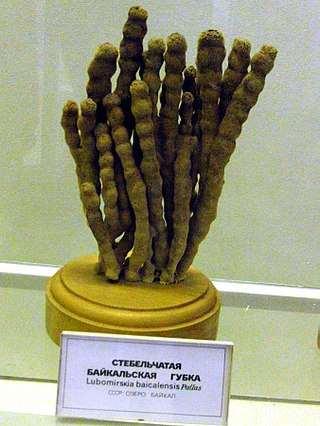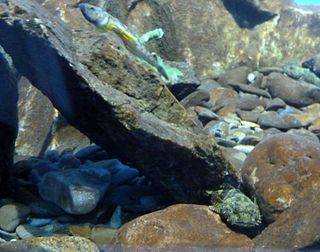
Lake Baikal is a rift lake in Russia. It is situated in southern Siberia, between the federal subjects of Irkutsk Oblast to the northwest and the Republic of Buryatia to the southeast. At 31,722 km2 (12,248 sq mi)—slightly larger than Belgium—Lake Baikal is the world's seventh-largest lake by surface area. However, because it is also the deepest lake, with a maximum depth of 1,642 metres, Lake Baikal is the world's largest freshwater lake by volume, containing 23,615.39 km3 (5,670 cu mi) of water or 22–23% of the world's fresh surface water, more than all of the North American Great Lakes combined. It is also the world's oldest lake at 25–30 million years, and among the clearest.

The Baikal seal, Lake Baikal seal or nerpa, is a species of earless seal endemic to Lake Baikal in Siberia, Russia. Like the Caspian seal, it is related to the Arctic ringed seal. The Baikal seal is one of the smallest true seals and the only exclusively freshwater pinniped species. A subpopulation of inland harbour seals living in the Hudson Bay region of Quebec, Canada, as well as the Saimaa ringed seal and the Ladoga seal, are also found in fresh water, but these seals are part of species that also have marine populations.

The Cottidae are a family of fish in the superfamily Cottoidea, the sculpins. It is the largest sculpin family, with about 275 species in 70 genera. They are referred to simply as cottids to avoid confusion with sculpins of other families.

Comephorus, known as the golomyankas or Baikal oilfish, are a genus comprising two species of peculiar, sculpin fishes endemic to Lake Baikal in Russia. Comephorus is the only genus in the subfamily Comephorinae. Golomyankas are pelagic fishes and the main food source for the Baikal seal.

Epischurella baikalensis is a species of copepod in family Temoridae. It is endemic to Lake Baikal, being the dominant zooplankton species there: 80%–90% of total biomass. It measures 1.5–2 mm (0.06–0.08 in).

Lubomirskia baikalensis is a freshwater species of sponge that is endemic to Lake Baikal, Russia. It is commonly called the Lake Baikal sponge and it is the most abundant sponge in the lake, but all the approximately 15 species of sponges in the family Lubomirskiidae are restricted to Baikal.
Abyssocottus elochini is a species of ray-finned fish belonging to the family Cottidae, the typical sculpins. These sculpins are endemic to Lake Baikal in Russia. It is known to dwell at a depth range of 250–300 metres.
Asprocottus abyssalisis a species of ray-finned fish belonging to the family Cottidae, the typical sculpins. These sculpins are endemic to Lake Baikal in Russia. It was described by Dmitrii Nikolaevich Taliev in 1955, originally as a subspecies of Asprocottus herzensteini. It is a freshwater fish which is endemic to Lake Baikal, Russia. It is known to dwell at a depth range of 150–1400 metres.
Asprocottus korjakovi is a species of ray-finned fish belonging to the family Cottidae, the typical sculpins. This species is endemic to the ancient lake Baikal in Siberia. It is a member of the deepwater sculpin family Abyssocottidae, and was described scientifically by Valentina Sideleva in 2001.
Asprocottus minor is a species of ray-finned fish belonging to the family Cottidae, the typical sculpins. It was described by Valentina Grigorievna Sideleva in 2001, originally as a subspecies of Asprocottus korjakovi. It is a freshwater fish which is endemic to Lake Baikal, Russia.
Asprocottus platycephalus is a species of ray-finned fish belonging to the family Cottidae, the typical sculpins. It was described by Dmitrii Nikolaevich Taliev in 1955, originally as a subspecies of Asprocottus herzensteini. It is a freshwater fish which is endemic to Lake Baikal, Russia. It is known to dwell at a depth range of 50–800 metres, most commonly between 250 and 460 m. Males can reach a maximum total length of 10.5 centimetres.
Asprocottus pulcher is a species of ray-finned fish belonging to the family Cottidae, the typical sculpins. It was described by Dmitrii Nikolaevich Taliev in 1955. It is a freshwater fish which is endemic to Lake Baikal, Russia. It is known to dwell at a depth range of 50–250 metres.
Cyphocottus eurystomus is a species of ray-finned fish belonging to the family Cottidae, the typical sculpins. These sculpins are endemic to Lake Baikal in Russia. It was described by Dmitrii Nikolaevich Taliev in 1955, originally as a subspecies of Asprocottus megalops. It is a freshwater fish which is endemic to Lake Baikal, Russia. It is known to dwell at a depth range of 50–600 metres.
Limnocottus bergianus is a species of ray-finned fish belonging to the family Cottidae, the typical sculpins. It was described by Dmitrii Nikolaevich Taliev in 1935. It is a freshwater fish which is endemic to Lake Baikal, Russia. It is known to dwell at a depth range of 100–1000 metres. Males can reach a maximum total length of 22.5 centimetres.
Limnocottus griseus is a species of ray-finned fish belonging to the family Cottidae, the typical sculpins. It was described by Dmitrii Nikolaevich Taliev in 1955, originally as a subspecies of Abyssocottus godlewskii. It is a freshwater fish which is endemic to Lake Baikal, Russia. It is known to dwell at a depth range of 250–1300 metres.
Neocottus thermalis is a species of ray-finned fish belonging to the family Cottidae, the typical sculpins. It was described by Valentina Grigorievna Sideleva in 2002. It is a freshwater, deep water-dwelling fish which is endemic to Lake Baikal, in Russia. It is known to dwell at a depth range of 430 to 480 metres.
Procottus gotoi is a species of ray-finned fish belonging to the family Cottidae, the typical sculpins. It is endemic to Lake Baikal in Siberia. This species was first formally described in 2001 by Valentina Grigorievna Sideleva.
Procottus jeittelesii, the red sculpin or red Baikal sculpin, is a species of ray-finned fish belonging to the family Cottidae, the typical sculpins. This species is endemic to Lake Baikal in Russia. It is a freshwater fish that dwells under stones or in holes in the mud at a depth range of 0 to 800 m. It is often found at around 100 m (330 ft), and is most abundant during the autumn and winter. From the late winter to the spring it breeds at depths of 5 to 30 m. It can reach a maximum length of 18 cm (7.1 in), but typically is 10–12 cm (3.9–4.7 in). It has a red spotted or banded pattern on a light background. The red sculpin resembles two of its close relatives, the smaller P. gurwici and the larger P. major.

Lubomirskiidae is a family of freshwater sponges from Lake Baikal in Russia.

The Baikal yellowfin, also known as the yellow-finned sculpin or yellow-wing sculpin, is a species of freshwater ray-finned fish belonging to the family Cottidae, the typical sculpins. This species is endemic to Lake Baikal and its tributaries in Siberia, Russia. It is most common in the southern part of the lake and lives from near the shore to a depth of 300 m (980 ft).








